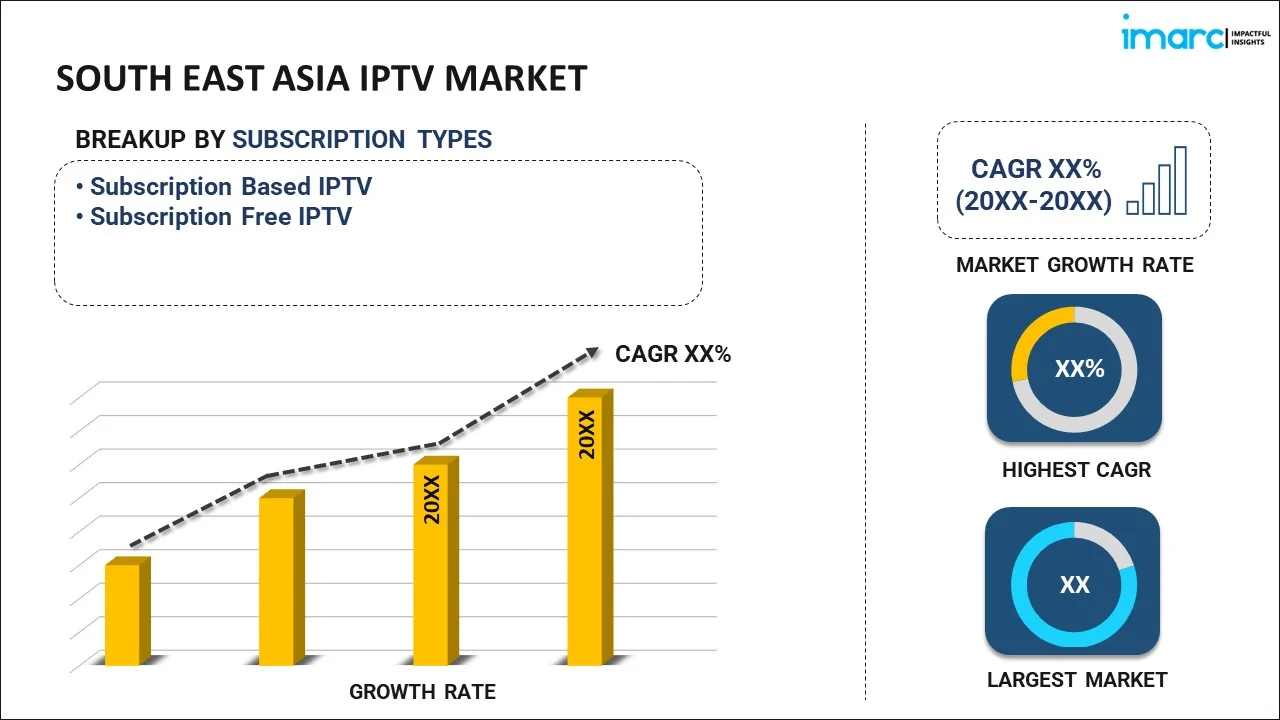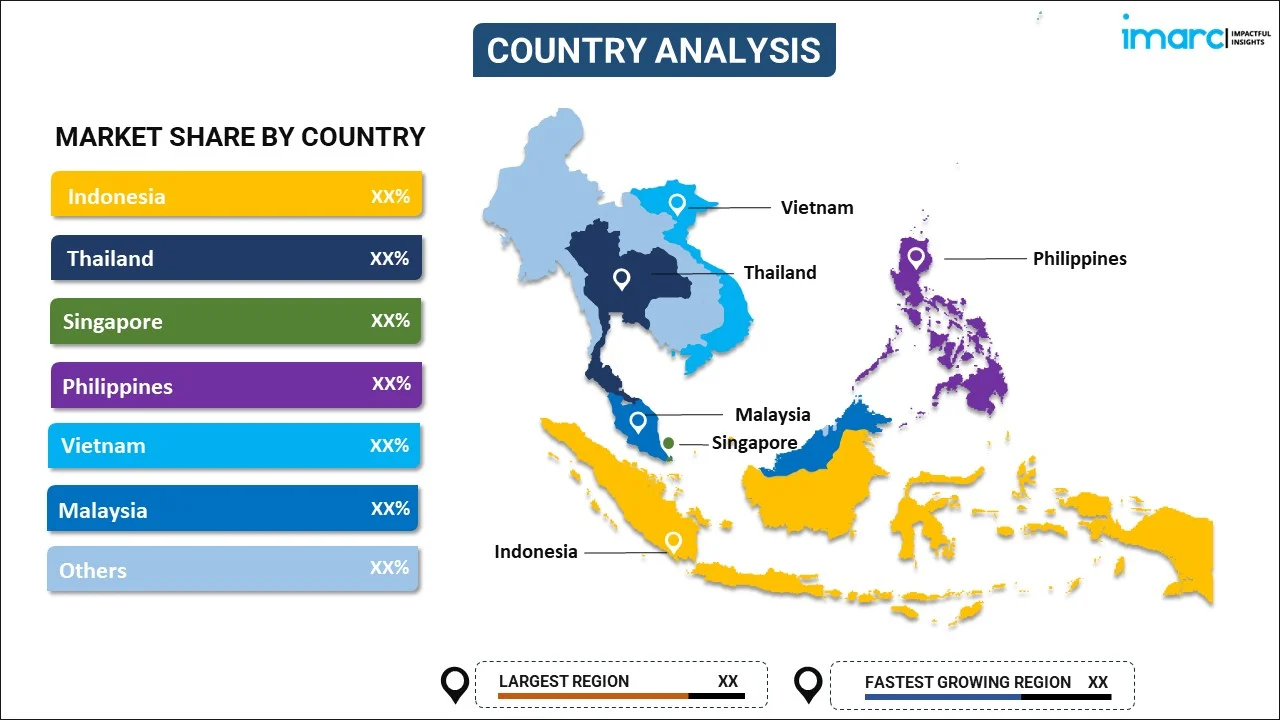
South East Asia IPTV Market Report by Subscription Type (Subscription Based IPTV, Subscription Free IPTV), Transmission Type (Wired, Wireless), Device Type (Smartphones and Tablets, Smart TVs, PCs, and Others), Streaming Type (Video IPTV, Non-Video IPTV), Service Type (In-House Service, Managed Service), End User (Residential, Enterprises), and Country 2024-2032
Market Overview:
South East Asia IPTV market size is projected to exhibit a growth rate (CAGR) of XX% during 2024-2032. Improving broadband infrastructures and the continuous technological advancements are primarily driving the market growth across the region.
|
Report Attribute
|
Key Statistics
|
|---|---|
|
Base Year
|
2023 |
|
Forecast Years
|
2024-2032
|
|
Historical Years
|
2018-2023
|
| Market Growth Rate (2024-2032) | XX% |
IPTV, also called internet protocol television, is the method of delivering television programs and videos via the internet. Video servers transmit signals through rooftop antennas, satellite dishes, and fiber optic cables to distribute content to various locations. For streaming content, IPTV predominantly utilizes IP multicasting, employing protocols such as Internet Group Management Protocol (IGMP), Real-Time Streaming Protocol (RTSP), Real-Time Messaging Protocol (RTMP), and Hypertext Transfer Protocol (HTTP). In line with this, unlike the public internet, IPTV also offers network operators increased control over video traffic, facilitating regular quality checks of the service. Additionally, it empowers viewers to curate personalized channel lists and record shows in high-definition (HD) quality.
South East Asia IPTV Market Trends:
The South East Asia IPTV market is experiencing robust growth and evolution, driven by factors such as increasing internet penetration, rising demand for on-demand content, and the region's expanding telecommunications infrastructure. One of the key drivers is the growing access to high-speed internet across the region. As more households and businesses gain reliable internet connectivity, the demand for IPTV services has surged. Additionally, the growing use of advanced protocols ensures a seamless and high-quality streaming experience for users, which is acting as another significant growth-inducing factor. Operators in the region are leveraging IPTV to provide value-added services, such as interactive features, video-on-demand libraries, and the ability for users to create custom channel lists. This level of customization and convenience has contributed to the popularity of IPTV in South East Asia, where viewers seek tailored and on-the-go entertainment options. Furthermore, industry players are responding with strategic partnerships, content collaborations, and technological innovations to stay competitive in this dynamic landscape. As the market continues to evolve, the South East Asia IPTV sector is poised to play a pivotal role in shaping the future of television consumption in the region over the forecasted period.
South East Asia IPTV Market Segmentation:
IMARC Group provides an analysis of the key trends in each segment of the market, along with forecasts at the regional and country levels for 2024-2032. Our report has categorized the market based on subscription type, transmission type, device type, streaming type, service type, and end user.
Subscription Type Insights:

- Subscription Based IPTV
- Subscription Free IPTV
The report has provided a detailed breakup and analysis of the market based on the subscription type. This includes subscription based IPTV and subscription free IPTV.
Transmission Type Insights:
- Wired
- Wireless
A detailed breakup and analysis of the market based on transmission type have also been provided in the report. This includes wired and wireless.
Device Type Insights:
- Smartphones and Tablets
- Smart TVs
- PCs
- Others
The report has provided a detailed breakup and analysis of the market based on the device type. This includes smartphones and tablets, smart TVs, PCs, and others.
Streaming Type Insights:
- Video IPTV
- Non-Video IPTV
A detailed breakup and analysis of the market based on streaming type have also been provided in the report. This includes video IPTV and non-video IPTV.
Service Type Insights:
- In-House Service
- Managed Service
The report has provided a detailed breakup and analysis of the market based on the service type. This includes in-house service and managed service.
End User Insights:
- Residential
- Enterprises
A detailed breakup and analysis of the market based on the end user have also been provided in the report. This includes residential and enterprises.
Country Insights:

- Indonesia
- Thailand
- Singapore
- Philippines
- Vietnam
- Malaysia
- Others
The report has also provided a comprehensive analysis of all the major regional markets, which include Indonesia, Thailand, Singapore, Philippines, Vietnam, Malaysia, and Others.
Competitive Landscape:
The market research report has also provided a comprehensive analysis of the competitive landscape in the market. Competitive analysis such as market structure, key player positioning, top winning strategies, competitive dashboard, and company evaluation quadrant has been covered in the report. Also, detailed profiles of all major companies have been provided.
South East Asia IPTV Market Report Coverage:
| Report Features | Details |
|---|---|
| Base Year of the Analysis | 2023 |
| Historical Period | 2018-2023 |
| Forecast Period | 2024-2032 |
| Units | US$ Million |
| Scope of the Report | Exploration of Historical and Forecast Trends, Industry Catalysts and Challenges, Segment-Wise Historical and Predictive Market Assessment:
|
| Subscription Types Covered | Subscription Based IPTV, Subscription Free IPTV |
| Transmission Types Covered | Wired, Wireless |
| Device Types Covered | Smartphones and Tablets, Smart TVs, PCs, Others |
| Streaming Types Covered | Video IPTV, Non-Video IPTV |
| Service Types Covered | In-House Service, Managed Service |
| End Users Covered | Residential, Enterprises |
| Countries Covered | Indonesia, Thailand, Singapore, Philippines, Vietnam, Malaysia, Others |
| Customization Scope | 10% Free Customization |
| Report Price and Purchase Option | Single User License: US$ 3699 Five User License: US$ 4699 Corporate License: US$ 5699 |
| Post-Sale Analyst Support | 10-12 Weeks |
| Delivery Format | PDF and Excel through Email (We can also provide the editable version of the report in PPT/Word format on special request) |
Key Questions Answered in This Report:
- How has the South East Asia IPTV market performed so far and how will it perform in the coming years?
- What has been the impact of COVID-19 on the South East Asia IPTV market?
- What is the breakup of the South East Asia IPTV market on the basis of subscription type?
- What is the breakup of the South East Asia IPTV market on the basis of transmission type?
- What is the breakup of the South East Asia IPTV market on the basis of device type?
- What is the breakup of the South East Asia IPTV market on the basis of streaming type?
- What is the breakup of the South East Asia IPTV market on the basis of service type?
- What is the breakup of the South East Asia IPTV market on the basis of end user?
- What are the various stages in the value chain of the South East Asia IPTV market?
- What are the key driving factors and challenges in the South East Asia IPTV?
- What is the structure of the South East Asia IPTV market and who are the key players?
- What is the degree of competition in the South East Asia IPTV market?
Key Benefits for Stakeholders:
- IMARC’s industry report offers a comprehensive quantitative analysis of various market segments, historical and current market trends, market forecasts, and dynamics of the South East Asia IPTV market from 2018-2032.
- The research report provides the latest information on the market drivers, challenges, and opportunities in the South East Asia IPTV market.
- Porter's five forces analysis assist stakeholders in assessing the impact of new entrants, competitive rivalry, supplier power, buyer power, and the threat of substitution. It helps stakeholders to analyze the level of competition within the South East Asia IPTV industry and its attractiveness.
- Competitive landscape allows stakeholders to understand their competitive environment and provides an insight into the current positions of key players in the market.
Need more help?
- Speak to our experienced analysts for insights on the current market scenarios.
- Include additional segments and countries to customize the report as per your requirement.
- Gain an unparalleled competitive advantage in your domain by understanding how to utilize the report and positively impacting your operations and revenue.
- For further assistance, please connect with our analysts.
 Inquire Before Buying
Inquire Before Buying
 Speak to an Analyst
Speak to an Analyst
 Request Brochure
Request Brochure
 Request Customization
Request Customization




.webp)




.webp)












